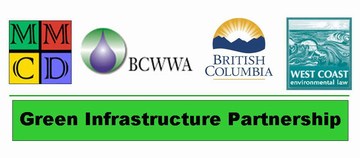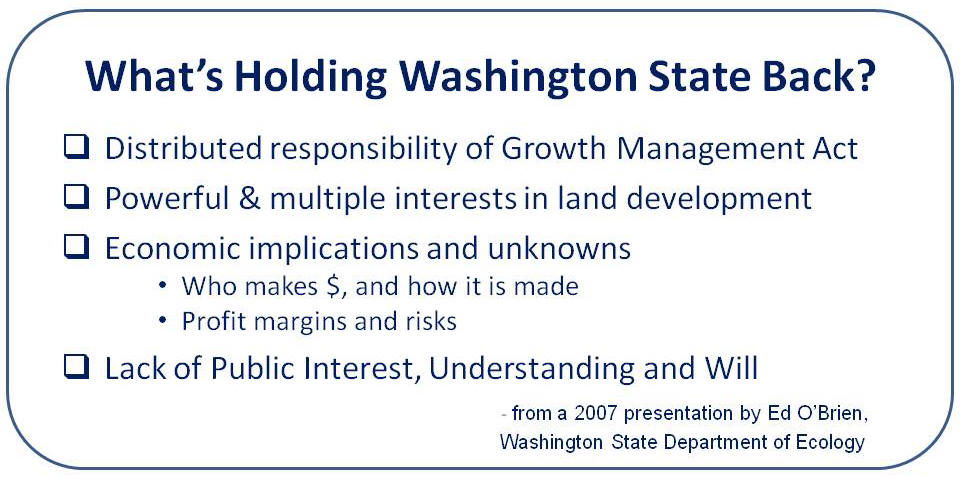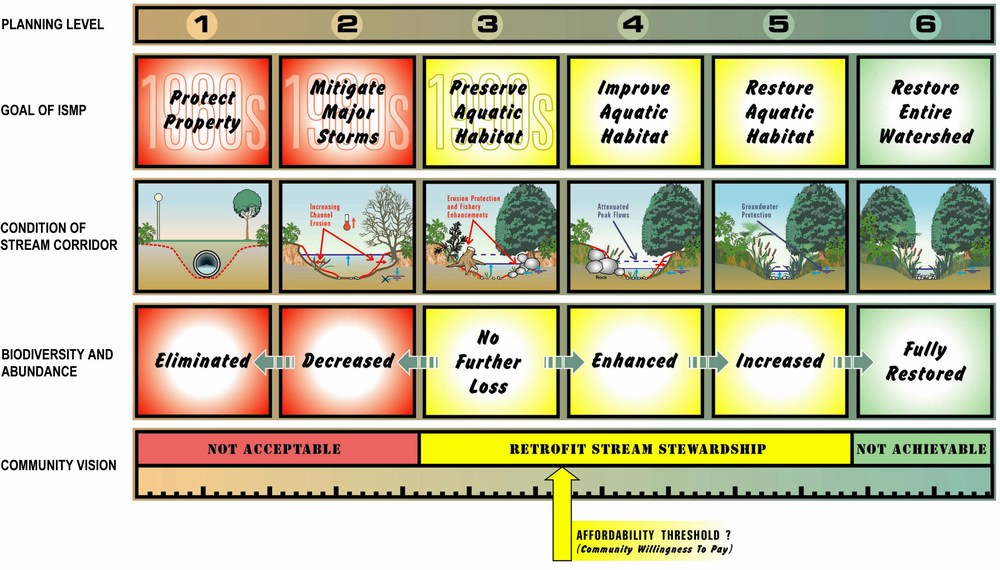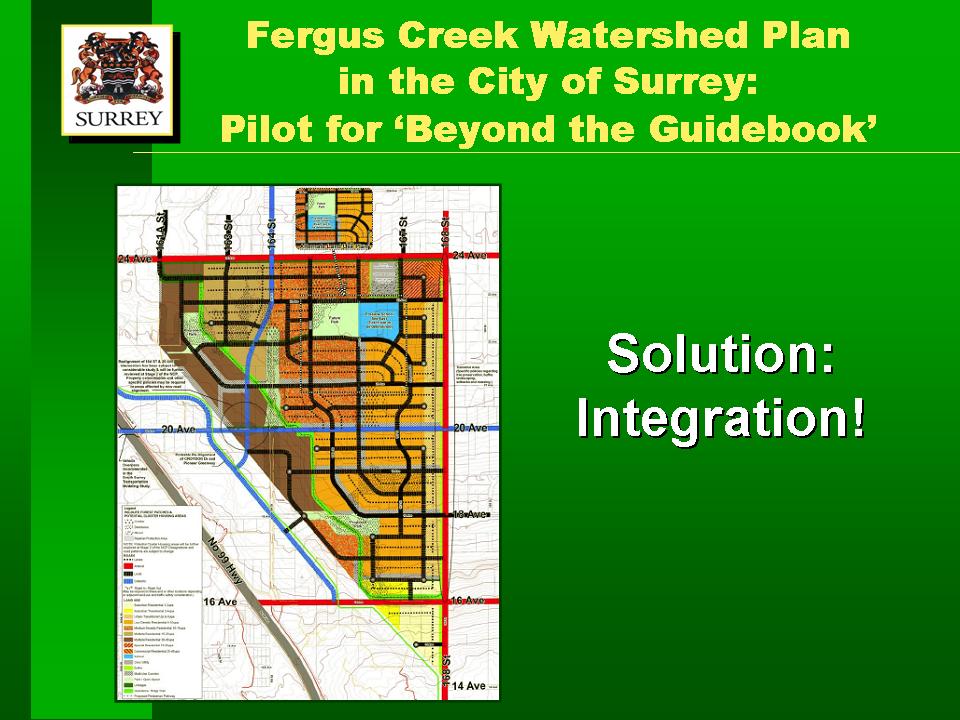Rainwater Management on Diverging Paths in British Columbia and Washington State?
Stormwater Management and
Low Impact Development
In October 2007, the American Water Resources Association and the Canadian Water Resources Association co-hosted a conference in Seattle that included a cross-border panel session on Stormwater Management and Low Impact Development. Three questions framed the panel presentations and surrounding discussion:
- What effects have technology improvements and increasingly stringent rainwater/stormwater management requirements over the past 20 years had on the water quality of receiving waters?
- How will those resources be affected by burgeoning population growth and development in the future?
- And what lessons can Washington State and British Columbia learn from each other as they strive to minimize the impacts of rainwater/stormwater runoff?
The panel session created a timely opportunity to compare an American top-down prescriptive approach versus a Canadian bottom-up educational approach.
To Learn More:
Download a copy of the entire conference program: Transboundary Water Resources of Washington State and British Columbia.
Download a copy of this web story: Rainwater Management on Diverging Paths in British Columbia and Washington State.
The Cross-Border Panel
Kim Stephens and Remi Dubé provided a British Columbia perspective, while Ed O’Brien and Gary Minton provided a Washington State perspective.
- Kim Stephens is the Program Coordinator for the Water Sustainability Action Plan for British Columbia, and was principal author of Stormwater Planning: A Guidebook for British Columbia.
- Remi Dubé is the City of Surrey’s Drainage Planning Manager, and is on the steering committee for the inter-governmental partnership that developed the Water Balance Model for British Columbia.
- Ed O’Brien is an Environmental Engineer with the Washington Department of Ecology, and was a contributing author to the 2001 and 2005 editions of the Stormwater Management Manual for Western Washington
- Dr. Gary Minton has been a leading contributor to the development of design criteria for rainwater/stormwater treatment relevant to the conditions of the Pacific Northwest. He is the author of the textbook Stormwater Treatment.
 The panel session was moderated by Chris Pitre, an associate and senior water resources project manager at Golder Associates. According to Chris, “When the panel members reflected on what each would be talking about, it quickly became clear that the order of presentation should be Ed O’Brien first, Gary Minton second, and the team of Kim Stephens and Remi Dube third.”
The panel session was moderated by Chris Pitre, an associate and senior water resources project manager at Golder Associates. According to Chris, “When the panel members reflected on what each would be talking about, it quickly became clear that the order of presentation should be Ed O’Brien first, Gary Minton second, and the team of Kim Stephens and Remi Dube third.”
Presentation Overviews
“As Kim observed during these pre-conference discussions,” continued Chris Pitre, “Our choice is to either end on a glass half-empty or glass half-full note. He said let’s show our audience that there is hope because Remi and I have a good news story to tell.”
Ed O’Brien:
The lead-off presentation by Ed O’Brien was titled Aquatic Natural Resource Protection and Rehabilitation in Urban and Urbanizing Areas Requires Significant Societal Change .
Stormwater management in Washington has evolved since the earliest days of settlement. The late 1970’s and 80’s saw the inception of standards for protecting the aquatic natural resources. According to Ed O’Brien, “While treatment and flow control crept into local standards and have become more stringent, the science tells us end-of-pipe controls are inadequate to protect the resources.”
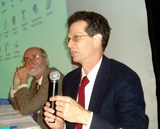 “Low Impact Development…or LID as it is typically called…is heralded as the way to have development and high quality resources too,” continued O’Brien, “But without watershed-scale restrictions on the extent of land disturbance, LID approaches will also fail.”
“Low Impact Development…or LID as it is typically called…is heralded as the way to have development and high quality resources too,” continued O’Brien, “But without watershed-scale restrictions on the extent of land disturbance, LID approaches will also fail.”
O’Brien posed this question: “Is society willing to make the sacrifices – lifestyle changes, property restrictions, tax increases – likely necessary to protect the resource?”
Dr. Gary Minton:
Dr. Gary Minton followed with a presentation titled What about the other 190%?-Application of Stormwater BMPs to Present and Future Development. The focus of his presentation was on rainwater/stormwater treatment.
 “Considerable progress has been made in the acceptance of Low Impact Development concepts, which is heartening,” emphasized Gary Minton, “However, we must not forget that LID whether of new developments or as retrofit will affect a relatively small percentage of development over the next few decades, perhaps on the order of 10%.”
“Considerable progress has been made in the acceptance of Low Impact Development concepts, which is heartening,” emphasized Gary Minton, “However, we must not forget that LID whether of new developments or as retrofit will affect a relatively small percentage of development over the next few decades, perhaps on the order of 10%.”
“We therefore must not lose sight of the reality that the vast majority of new development will be traditional and that retrofitting will have a modest impact in the near future,” warned Minton.
Gary emphasized that US and Canadian stormwater manuals are not keeping pace with recent findings from field studies. He recommended several modifications to the design of common treatment BMPs like wet ponds and grass swales that improve performance, yet require no more and possibly less space than currently used . As for the 100%, he suggested simpler ways to reduce connected impervious surface and pavement sweeping to reduce existing nonpoint pollution loads.
He concluded by stating that: “We must not forget the other “190%:” The 90% of new development that will be traditional and the currently built environment, i.e. 100%, that is the cause of our existing problems stemming from excessive stormwater.”
Kim Stephens and Remi Dubé:
Kim Stephens and Remi Dubé concluded with Beyond the Guidebook: Designing with Nature to Create Liveable Communities and Protect Stream Health. In Part One, Kim Stephens described the practice of rainwater management as it has evolved over the past forty years in British Columbia. In Part Two, Remi Dubé described future directions.
According to Kim Stephens, “In 2002, when Stormwater Planning: A Guidebook for British Columbia was published, its underlying premise that land development and watershed protection can be compatible represented a radical shift in thinking.”
“The Guidebook recognized that water volume is something over which local government has control through its infrastructure policies, practices and standards,” explained Kim Stephens, “The Guidebook focus on volume control was the catalyst for a change in thinking that has resulted in innovation at the site scale.”
“ Beyond the Guidebook is an inter-governmental initiative that builds on this foundation by advancing a runoff-based approach and decision support tool,” added Remi Dubé, “We are incorporating all the lessons learned to date to correlate runoff volume management with urban stream health at a watershed scale.”
Beyond the Guidebook is an inter-governmental initiative that builds on this foundation by advancing a runoff-based approach and decision support tool,” added Remi Dubé, “We are incorporating all the lessons learned to date to correlate runoff volume management with urban stream health at a watershed scale.”
British Columbia Perspective
In the second half of the 1990s, Kim Stephens of British Columbia and Bill Derry of Washington State collaborated to conduct some 20 workshops sponsored by local governments throughout British Columbia. These events had a major impact in stimulating and influencing discussion regarding a ‘science-based’ ecosystem approach to integration of stormwater management and land use planning.
Bill Derry was one of the first stormwater utility managers in Washington State. He believed so strongly in the need for scientifically-defensible research that he convinced his fellow utility managers to organize and fund a research centre at the University of Washington. Bill was a Founding Director of the Center for Urban Water Resources Management (which is now part of the Center for Water and Watershed Studies).
Translating the Science
In British Columbia, Bill Derry’s reputation for providing leadership was based on having access to the latest scientific findings. His knowledge was a key ingredient in creating what became known as the ‘fish picture’ graphics. These illustrated the consequences of urbanization on aquatic abundance and diversity.
Stephens and Derry used the graphics to ‘translate the science’ and develop a common understanding among broad and diverse audiences in a workshop setting. Starting with the City of Kelowna in July 1998, the graphic above helped a number of municipalities in British Columbia pass Council Resolutions that represented the first steps down a pathway that will ultimately lead to implementation of 20-year and 50-year visions for greener, more livable communities.
These province-wide workshops led to the SmartStorm Forum Series of four transformational events during the period 1999 through 2001. The Guidebook was an outcome.
Overcoming Fear and Doubt
 According to Kim Stephens, “A decade ago, British Columbia and Washington State had the same science and a common understanding of what it meant. We had the same point of departure. A decade later, we are on diverging paths. In British Columbia, we are changing the way we develop land. Washington State is not.”
According to Kim Stephens, “A decade ago, British Columbia and Washington State had the same science and a common understanding of what it meant. We had the same point of departure. A decade later, we are on diverging paths. In British Columbia, we are changing the way we develop land. Washington State is not.”
“Circa 2000, our mantra in British Columbia was Overcoming Fear and Doubt,” continued Stephens, “We were literally hanging on by our fingernails. We knew that if we failed to change land development practices, it would be another generation before anyone would try again. So we said…we must not fail; and we did not fail.”
Adaptive Management
Stephens also commented on how the research work he and Bill Derry undertook for King County on the Role of Adaptive Management in the Tri-County Puget Sound Response to the Endangered Species Act is being applied in British Columbia. “Adaptive management is a core element of the Fergus Creek plan,” added Remi Dubé.
The goal of adaptive management is to learn from experience and constantly improve land development and rainwater management practices over time. This requires ongoing monitoring of demonstration projects to assess progress towards performance targets and the shared watershed vision.
What the Science is Telling Us
Ed O’Brien, in his presentation, stated that: “Locally, our knowledge was and still is way ahead of the federal game because of Puget Sound Plan initiatives and a few forward-thinking local governments. The federal rules impede our progress in implementing strategies and requirements that we know are necessary.”
Kim Stephens agreed. “Rainwater management practice in Washington State is apparently being driven by a water quality regulation when a decade ago the science…and in particular the work of Rich Horner and Chris May…told us that changes in hydrology, not water quality, must be the focus of our efforts. If you get the hydrology right, water quality typically takes care of itself.”
Stephens, Dubé, Minton and O’Brien agreed on the need to tackle land use because that is where changes in hydrology are created. “We have a number of manuals in Washington State, but the design criteria don’t reflect what we have learned,” observed Gary Minton.
Minton and O’Brien both commented on the limited effectiveness of end-of-pipe solutions. “Yet that is where all your effort is going….into ponds at the end of piped conveyance systems,” commented Kim Stephens. “Yes, and the ponds are over-sized,” added Gary Minton.
The integration of rainwater management and land use is the differentiator between British Columbia and Washington State. “In Washington State, we cannot achieve environmental protection using current methods of development,” bemoaned Ed O’Brien, “Not many new developments are applying low impact development techniques. There isn’t a land use dictator who can demand change. It will take public education to instill a culture change for us to have any hope that we can protect aquatic resources in the urban environment.”
Fergus Creek in the City of Surrey
The City of Surrey’s Fergus Creek watershed plan is a pilot for the current Beyond the Guidebook initiative in British Columbia. This process started with the East Clayton Sustainable Community and continued with the Campbell Heighs Industrial Area.
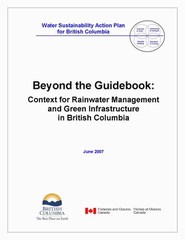 According to Kim Stephens, “The City of Surrey is ‘walking the sustainability talk’ and is demonstrating regional leadership in Metro Vancouver by proactively implementing a design with nature approach to green infrastructure practices.”
According to Kim Stephens, “The City of Surrey is ‘walking the sustainability talk’ and is demonstrating regional leadership in Metro Vancouver by proactively implementing a design with nature approach to green infrastructure practices.”
Remi Dubé reported that no large-scale storage ponds will be built in the Fergus watershed: “We will be implementing ‘green solutions’ as an alternative to conventional engineered ‘blue solutions’. Rainwater runoff volume will be managed through constructed facilities and the creation of contiguous large-scale greenways that have been integrated into the area’s land use plan.”
“The science-based analytical methodology that we have validated through the Fergus Creek process now enables the City of Surrey and other local governments to explore the fundamental requirements both explicit and implicit in Federal Fisheries Guidelines for stream health and environmental protection,” concluded Remi Dubé.
Designing with Nature in British Columbia
“In British Columbia, we have made a conscious decision to go the educational route,” reported Kim Stephens, “It is all about establishing expectations and creating an environment that encourages innovation and gets practitioners excited about what they are doing. The culture is changing.”
“We call our approach designing with nature,” continued Remi Dubé, “We have borrowed from the teachings of Ian McHarg because we believe this is the way we will create livable communities and protect stream health.”
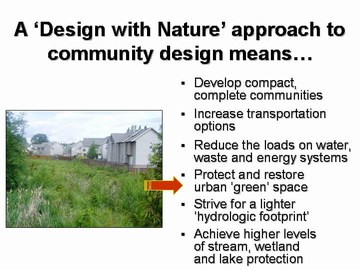
According to Kim Stephens: “We are creating change through on-the-ground partnerships – for example, the Green Infrastructure Partnership, a consortium of government and no-government organizations. Finding the right solution is an outcome of sharing a vision about what we want our communities to look like, not because a government agency prescribed a regulation. For us, designing with nature has become a rallying cry.”
Stephens added this soft approach is bearing fruit: “We are celebrating on-the-ground successes through programs such as the Showcasing Green Infrastructure Innovation Series. We are learning how to create a self-fulfilling prophecy. Increasingly we hear people say that the tide has turned. Major land developers want to be seen as innovative. As a result, practitioners are investing a lot of time, energy and resources in making rainwater capture systems effective. Green infrastructure is becoming part of our ethic. ”
“Green infrastructure is a work-in-progress in British Columbia. We have by no means achieved Nirvana, but we are on the right path. We are steadily but surely making the shift from single-function stormwater management to the integrated and comprehensive perspective that is captured by the term rainwater management,” concluded Remi Dubé.
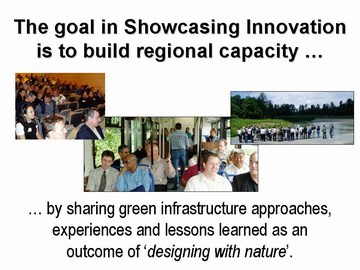
Water Sustainability Action Plan for British Columbia
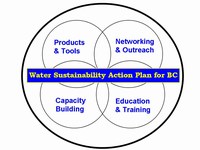 The Water Sustainability Action Plan for British Columbia is sponsored by the Province of British Columbia, and the Action Plan elements are being delivered through partnerships, one of which is the Green Infrastructure Partnership. The Action Plan provides a partnership umbrella for an array of on-the-ground initiatives that promote a ‘water-centric’ approach to community planning and development. .
The Water Sustainability Action Plan for British Columbia is sponsored by the Province of British Columbia, and the Action Plan elements are being delivered through partnerships, one of which is the Green Infrastructure Partnership. The Action Plan provides a partnership umbrella for an array of on-the-ground initiatives that promote a ‘water-centric’ approach to community planning and development. .
The mission of the Green Infrastructure Partnership is to provide leadership and encourage others to implement ‘design with nature’ design practices and regulation province-wide. Implementation by local governments will be voluntary, but once the decision is made to embrace green infrastructure, implementation will need clearly defined standards.
